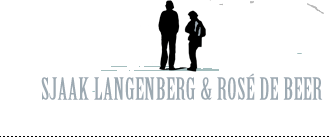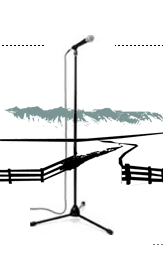




Sjaak Langenberg's texts often serve as a starting point for an intervention or a project, but they can also be read as independent dissertations. It's not uncommon for a publication to come out of a project, but Langenberg also writes columns and essays outside the context of projects. These frequently find a place in publications in magazines, catalogues, newspapers or his own publications.

 |
Kunstnarhuset Messen is situated in the village of Ålvik (Norway) by the Hardangerfjord. Many artists praise the beauty of the Hardangerfjord and the Hardanger bunad became Norway's national costume, but there is also a tradition of heavy industry in some villages at the fjord. During their stay as artists in residence in Ålvik in 2011 Sjaak Langenberg and Rosé de Beer developed new public art proposals which respond to national romanticism and tourism in the Hardanger area. Sjaak Langenberg wrote an article about their stay in the Dutch BK-informatie magazine. In 2012 Langenberg and De Beer returned to Kunstnarhuset Messen to further develop and execute their plans.
‘Velkommen kunstnar! The community of Kvam is located in a beautiful spot on the Hardangerfjord. Lots of artists live here, but we’d like to have even more!’ With this eye-catching announcement in BK-informatie magazine in the autumn of 2007, Kwam attempted to entice artists to come to Norway and base themselves on the Hardangerfjord. In a fully catered for Kvammalokk-weekend, the selected artists were pampered with boat trips across the fjord and cultural excursions. Immediate reason behind this remarkable action was the imminent closure of a large factory in the village of Ålvik. Many of the 600 inhabitants of that village worked in the factory. Facilities in the village were coming under pressure. Buildings would become abandoned. Kwam hoped to turn the tide with this ‘cultural revolution’. The stunt worked astonishingly well. Quite a number of artists emigrated to Norway following the weekend treat.
Despite the fact that the doors of the factory ultimately didn’t close, the new emigrants proceeded on their way with a Norwegian do-it-yourself mentality. A baby boom ensued, to the great satisfaction of the community whose ‘secret’ agenda was thus carried through – the rising number of inhabitants brought money from Oslo into the cash drawer. And in the former head office of the factory that did shut down, the Kunstnarhuset Messen artist in residence was founded.
This Norwegian fairytale is something that seems almost unimaginable in these days of full-scale cuts. Nevertheless, when, in the spring of this year, we took up residence in Messen, we were received with open arms. Whilst reports from the Netherlands were becoming gradually grimmer and grimmer, with demonstrations taking place against the policies of cultural destruction, we were continually surprised by the hospitality with which these small communities embraced the artists. Even more special was the fact that the compliments weren’t coming from the local culture lovers, but from farmers, citizens and factory workers. “Fantastic that artists are coming here!” shouted out the tenant of a boathouse. “You artists give so much back to society,” a factory worker said to the painter Paul Dikker, who was in Messen at the same time as us. The man was of the opinion that Dikker deserved a state stipend after so many years diligent work.
For a moment we contemplated applying for cultural asylum.
Before everyone starts packing their suitcases, a certain amount of nuance is called for. In the period immediately following our arrival, our feelings about our temporary residence were not so positive. We had made a conscious choice for this ‘remote’ place rather than a popular residency in one of the great metropolises where all the artists are clustered together. But now we were actually in Ålvik, the silence felt more suffocating than beneficent. Our work functioned fine off the road, in places where things weren’t happening, but at the same time, it is spurred on by interaction and communication. With whom could we communicate here? We encountered more hedgehogs than inhabitants. On top of that it rained more or less non-stop for the whole of the first month, and the smoke from the factory chimneys didn’t exactly cheer us up either.
The turn-around came after we were invited to take part in GREP Vandring på Fykse, a one-day art event in Fyksesund landscape park on a peninsula of the Hardangerfjord. There we discovered beautiful green stones piled alongside the road. They turned out to be waste material from the factory in Ålvik where ferro alloys are produced. In order to draw attention to the deceptive beauty of this waste in the landscape park, we put industrial souvenirs up for sale, using the name Ålvik Rock (freely adapted from the name of an annual heavy metal festival in Ålvik). We situated a salon table with the ‘precious stones’ on top of the pile of rocks at the side of the road, and left it up to the visitors – they could either pay a hefty price for the stones on the table or else take one for free from the pile. Like a designer who leaves the traces of the production process expressly visible in the end product, or a conjuror who gives away his own trick but still gets away with it, we deliberately undermined our own tourist trap.
The stones were frequently photographed or secretly picked off the pile when we weren’t paying attention (one was sold for 215 NOK), but more importantly, they were really looked at for the first time.
Through our participation in the event, just two weeks after our arrival, we were now among the Norwegians and we became acquainted with a lot of the people living on the fjord. It was the ideal introduction. We were no longer on an artists’ island in Ålvik, but felt as if we had become part of a network that extended over a large part of the fjord. And we participated in a tradition of artists playing a role in the representation of the area.
The wide Hardangerfjord with its fruit trees along the banks is seen by the Norwegians as the epitome of Norway. In her thesis Can art influence political policy on the environment? (2011) Stephanie Haas, student of the University of Oslo writes:
‘Norwegians are all aware of Hardangerfjord and associate it with natural beauty. Advertisers have used Norwegians’ positive emotional associations with Hardangerfjord to sell apple juice and other fruit products.’
Her conclusion is that, one painting in particular, Brudeferden i Hardanger (bridal procession in Hardanger, 1848) by Adolph Tidemand and Hans Gude, stimulated national pride. Artists became involved in the development of a revitalised national identity following 400 years of Danish occupation, and thanks to this fact, art was seen as something positive, a notion from which the positive fruits may be plucked right into the present day.
We were confronted with Norwegian pride on the national holiday to celebrate the constitution. In Øystese our eyes almost popped out of our heads at the sight of the masses of Norwegians in national costume huddled by a petrol station to shelter from the rain whilst they ate hot sausage rolls. A parade passed by twice – due to insufficient street length.
From a Dutch perspective national costume is piece of dying folklore. In Norway it’s cool to wear a bunad. This expensive costume is being worn more and more often by all sorts of festivities. Bunad magazine, which is published monthly, is a glossy, featuring models intended to appeal to the world of the young.
Øystese, a community of some 1,700 inhabitants, is home to the Kabuso Museum. Whoever imagines, having heard the description of the yearly parade, that this is a dusty local museum, would be seriously mistaken. Damien Hirst and Matthew Barney both exhibited there. The world of high art and local craftsmanship mix unproblematically in Norway. The Norwegian kulturråd refers to art and craft in one and the same breath. In comparison to the labels which we apply in the Netherlands, this came as an enormous relief.
At the pop festival Bygdalarm in Øystese we saw a mix of contemporary music and folklore. The festival terrain was enclosed using traditionally dried hay. The poster used bunad patterns as a reference. The bands took home smoked ham. Trendy young persons succumbed within an hour to cheerful collective drunkenness.
A field of tension between the beauty of the Hardanger region and the need for economic development has always existed. The heavy industry in some villages, the waterfalls that are exploited and the controversy about new electricity pylons which is reported weekly in the local newspaper, help to put the Norwegian fairytale into perspective. Tourism also takes its toll.
We developed propositions which responded to the traditions and tourism on the fjord. The deeper into the tourist season we got, the more the narrow roads became clogged with campers. We started (just as the Norwegians) to become irritated with this white mould, with the tourists who had filled their mobile home from home with products from their own land and set up their camps at free stopping points.
This tension culminated in the design for a sculpture of a camper balanced on bricks with a grass roof – a camper as stabbur, the traditional Norwegian food shed. From the sculpture, local food products could be sold as a statement against the parasitic attitude of the camping tourists. At the same time, it could develop into a tourist attraction, because every tourist would want to have their photograph taken alongside this sculpture.
Actually executing this plan once again brought us into contact with unusual local inhabitants – a Danish building constructor who had emigrated to Norway and who, during a business appointment, asked if we would first like to go and swim in the fjord with him, and Lars, the smiley kultursjef of Kwam community who, prior to taking on this particular function, had once been the television producer of Hotel Caesar, the best known Norwegian soap opera. We were continually being surprised by people’s openness and warm-heartedness.
The Norwegian fairytale was brutally interrupted by the bomb attacks in Oslo and the blood bath that Breivik brought about on Utøya. The Norwegians were in shock, but determined not to allow their attitude to life to change. The national minute of silence dissolved into the silence which is a constant presence in Ålvik. The bombing was in complete contrast to the sense of community which we encountered during our stay, a sense of community which also proclaims its receptivity to art and artists. Norway is a big country with relatively few inhabitants. If you want to survive on a fjord then you are forced to rely on one another. It’s enormously contra-productive to tell an artist that their contribution is irrelevant. You simply can’t afford to have that attitude here – however strange this may sound to Dutch ears which are used to hearing continual lamenting and cynicism, used to living in a society where we seem to no longer need one another, never mind needing artists.
It’s time we started to believe in fairytales again.
© Sjaak Langenberg, 2011. All rights reserved. This text is intended solely for personal use. No part of this publication may be reproduced or displayed without prior written permission from the author.

